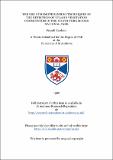Files in this item
The use of remote sensing techniques in the detection of upland vegetation communities in the North York Moors National Park
Item metadata
| dc.contributor.advisor | Soulsby, John A. | |
| dc.contributor.author | Kardono, Priyadi | |
| dc.coverage.spatial | 303 p. | en_US |
| dc.date.accessioned | 2018-06-15T13:25:27Z | |
| dc.date.available | 2018-06-15T13:25:27Z | |
| dc.date.issued | 1992 | |
| dc.identifier.uri | https://hdl.handle.net/10023/14123 | |
| dc.description.abstract | The North York Moors National Park was designated in 1952 to conserve the extensive area of open dry upland heath dominated by Calluna vulgaris. However, problems of moorland management have occurred with the loss of open moorland to agriculture, and forestry. Bracken encroachment, over-aging of heather, and soil erosion are further problems. In attempts to solve these problems, it is necessary to produce vegetation and land cover maps which can be achieved by using remote sensing techniques. This thesis examines the use of Landsat TM data and remote sensing techniques to produce an upland vegetation distribution map which may be useful as a data input for management planning. Landsat TM data acquired on 31st May 1985 were used to discriminate the upland vegetation communities in five sample areas: Blakey, Egton, Farndale, Glaisdale, and Whitby. A supervised box and maximum likelihood classification from the R-CHIPS image processing system is used to determine the distribution of vegetation classes. Spectral coincident plots and scatter diagrams of the training data were examined to produce classmaps. The Habitat maps, used as a guide during computer training stages were also used for assessing the accuracy of classification results. It is shown that the average accuracy of box classification result is about 77% whilst using maximum likelihood classification, overall accuracy of 85% has been achieved. It is shown that bracken, mature Calluna, young Calluna, coniferous plantation, improved grassland, and bryophytes were better discriminated whilst acid flush, acid grassland, and semi-improved acid grassland were less successfully identified. The potential and problems of the techniques are discussed and alternatives strategies to achieved better results are suggested. Using high spatial resolution data such as SPOT imagery, multi-temporal data acquisition, and image filtering may increase the classification accuracies. The combined use of image masking and maximum likelihood classification will reduce generalisation giving high classification accuracy. | en_US |
| dc.language.iso | en | en_US |
| dc.publisher | University of St Andrews | |
| dc.subject.lcc | QK306.K2 | en |
| dc.subject.lcsh | Botany—Methodology | en |
| dc.title | The use of remote sensing techniques in the detection of upland vegetation communities in the North York Moors National Park | en_US |
| dc.type | Thesis | en_US |
| dc.contributor.sponsor | Agency for the Assessment and Application of Technology | en_US |
| dc.type.qualificationlevel | Doctoral | en_US |
| dc.type.qualificationname | PhD Doctor of Philosophy | en_US |
| dc.publisher.institution | The University of St Andrews | en_US |
This item appears in the following Collection(s)
Items in the St Andrews Research Repository are protected by copyright, with all rights reserved, unless otherwise indicated.

